Hi, my name is Charlie Hart, and I am also known on social media as ‘Ausome Charlie’. Yes, that is ‘Ausome’ with an ‘Au’ for ‘Autistic’ - one of my self-assigned labels right there! I am a neurodiversity inclusion keynote speaker with a background in HR Analytics.
Starting to Self-Assign Labels
When I realised that I was autistic in 2018, I set up social media channels under the handle @AusomeCharlie to share my journey and learn from others with lived experience. This led me to thriving mutually supportive communities using the hashtags #ActuallyAutistic, #Neurodiversity and later #AuDHD.
After feeling like an outsider and a failure for so many years, the labels ‘Autistic’, ‘Neurodivergent’ and ‘AuDHD’ helped me learn to accept myself, then to start advocating for my needs, and to promote understanding and acceptance for all neurodivergent people through my work. Power can be found in labels, and from the community they help us to find.
The Validity of Self-identification of Neuro-Differences
For adults, self-identification often comes first. It must, for most adults who suspect they have a neurodevelopmental condition. Self-identification usually comes from both research and introspection (not from watching TikTok’s).
Look at my story: I had been experiencing anxiety states and recurring depression between 2003 and 2018, that is 15 years!
My doctor prescribed Propranolol (beta blockers) to alleviate the physical symptoms of my anxiety states, and Citalopram (Selective Serotonin Reuptake Inhibitors) for depression.
Me, I constantly pushed for answers about why my mental health was so fragile. I tried psychotherapy, mind-mapping, battling demons, cognitive behaviour therapy (CBT), self-help books… yet still the depression would return.
I was 99% sure I had bipolar disorder at one point, and I begged my doctor to refer me for assessment. When I was triaged by a psychiatric nurse, I was told: “bipolar disorder is cyclical, but you can identify specific triggers. You tell me you become depressed after extended periods of stress, so it is likely this is just anxiety and depression”. She suggested counselling, to build psychological skills.
No medical professional EVER suggested Autism or ADHD, despite my family history (my brother is also autistic and hyperactive).
Then in 2018 came my autistic identification, after it was picked up in my son. Without that epiphany, at the age of 42, I would still be struggling to cope, regularly in distress, lacking in self-compassion and unable to advocate for my needs.
Professional diagnosis is usually just a rubber stamp on what we already realised about ourselves. My school reports and performance reviews are riddled with signs of autism and ADHD, and personally I do not think I have ever passed for ‘normal’.

Image description: ‘Disconnect’ comic strip commissioned from Piper Strange Art by Ausome Charlie. Pane 1 depicts Charlie in a psychiatrist’s office for an autism assessment, the psychiatrist (a woman wearing a hijab) is saying ‘There’s a disconnect between your intent and how you come across. You clearly have autism’. Pane 2 depicts Charlie leaving the appointment smiling, and immediately texting her manager, Jayne. Text message to Jayne says, ‘I was right, I am autistic’ and Jayne’s reply says ‘Congratulations! Well, I assume you’re happy about it?’ and Charlie’s reply says ‘Delighted!’
I was later diagnosed with ADHD as well, which again started with self-identification. I had been describing myself as ‘AuDHD’ for a while. A ‘Queer AuDHDer’ in fact, as I prefer identity-first language and I like rhymes.
I still use the adjective ‘neurodivergent’ which is a positive and affirming socio-political label- not to be mistaken for a medical diagnosis! It does not make sense to me to juxtapose medical terminology with the language of the ‘Neurodiversity Paradigm’ therefore it does not make sense to be ‘diagnosed neurodivergent’ nor to refer to ‘neurodivergent conditions’).
I do recommend professional diagnosis, unless you are concerned about a diagnosis being career-limiting, or negatively impactful in some way, e.g. in the family courts, but I believe self-diagnosis of neurodevelopmental conditions is valid. There are so many barriers to diagnosis, and professional diagnosis is a privilege denied to many marginalised folks.
The ‘Neurodiversity Paradigm’ proposes that neurological diversity is advantageous within human populations - just as biodiversity is within an ecosystem.
The Power and the Paradox of Labels
Some labels are positive, life-affirming even, some may be unhelpful and self-limiting. Labels impact individuals, teams, and organisations in various ways. Labels play a role in shaping one’s identity and self-perception. ‘Anxious’ is not helpful to me. I need to understand the stressors, and how I can avoid them, how to mitigate their impact on me, or take the sting out of them. If I label myself ‘anxious’ this is not a neutral adjective to me; it is self-limiting. If I was a donut, my Autism is a core ingredient, part of the dough. Anxiety is just sprinkles, and not intrinsically who I am.
The role of labels is highly individual, and an entirely personal choice. For example, some people find comfort in the self-label ‘introvert’. Others may limit themselves with this, avoiding social occasions, possibly missing out on something they may otherwise have enjoyed, or like me at times in my life, convincing ourselves we cannot socialise without getting drunk.
Person-First Language versus Identity-First Language
We should all respect the individual’s personal choice. Their choice may depend on whether the individual sees the label as an adjective describing them, or a pathology. Also, whether they chose the label or was it foisted on them by adverse circumstances (I dislike the label ‘bereaved parent’, it is not inherent to my own identity- only my tragic circumstances).
I like to describe myself as ‘AuDHD’ because Autism and ADHD are, in my view, just adjectives describing me, but when I refer to Complex PTSD, I use person-first language, so I call myself an ‘AuDHDer’ but not a ‘C-PTSDer’.
Often, I don’t mind either way; I ‘have blonde hair’, or I am ‘a blonde’, and that makes no difference to me (but I can change my hair colour, not my neurotype).
I respect other people’s preferences when they are describing themselves, but I tend to get stroppy if others tell me how I must describe myself (’able-splaining’ their person-first language at me, as if it is up to them how I should self-identify).
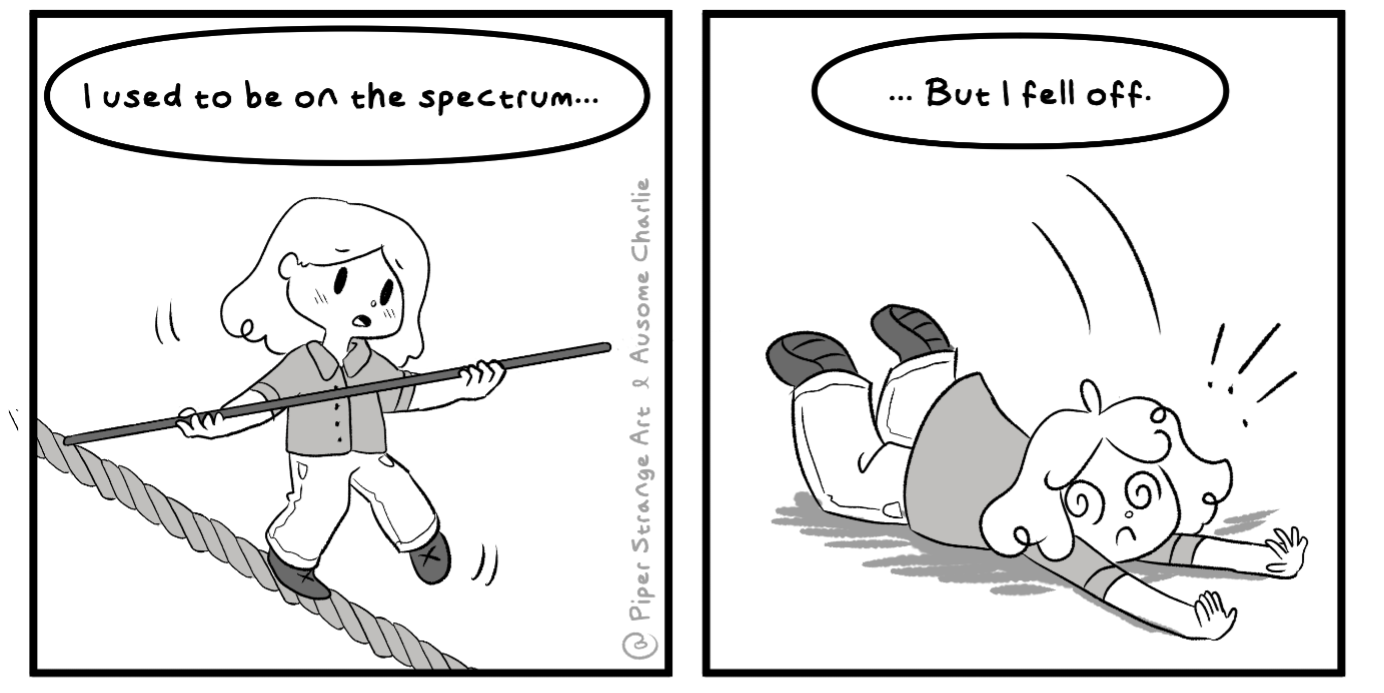
Image description: ‘On the spectrum’ comic strip commissioned from Piper Strange Art by Ausome Charlie. Pane 1 depicts Charlie balancing on a tightrope, thinking ‘I used to be on the spectrum’. Pane 2 shows Charlie falling off the tightrope, thinking ‘but I fell off’.
Who can Identify as Neurodivergent?
‘Neurodivergent’ is an ‘opt-in’ label. It can be very affirming, but when using it we need to remember this is a socio-political term not a medical diagnosis.
Anybody can call themselves ‘neurodivergent’ if they believe they do not have a standard-issue typical brain, that the way their mind works diverges from the dominant societal expectations of ‘normal’.
And, yes, ‘neurodivergent’ does include people whose cognitive functioning or neural pathways have been affected by mental health conditions.
Kassiane Asasumasu, who coined the term ‘neurodivergent’ explicitly includes psychiatric conditions, and they said the term is intended it to be inclusive, not exclusive.
Why gatekeep anyway? If it is helpful to you, then use it to describe yourself (but maybe avoid projecting it on others, unless you know they identify as neurodivergent).
‘Ally’ however is often self-assigned, whereas it is up to those in whatever marginalised community you claim to support whether they see you as their ally or not. Do you do any active acts of allyship? Are you an active bystander?
The Superpower Narrative
Let’s delve into the idea of neurodivergence as a ‘superpower’. Humans should not need super strengths or extraordinary skills to be considered valid, or valued, members of society. Every individual has their strengths and weakness, and inherent worth. The neurodiversity movement is a social justice movement, not capitalism. We are not here to continue the work of Frederick W Taylor, or Hans Asperger!
‘Low-functioning’ denies value and agency. ‘High-functioning’ denies support and minimises our struggles. ‘Mild autism’ suggests the existence of ‘spicy autism’, but autism is a ‘dynamic disability’ - its impact fluctuating, and highly contextual.
‘Disabled’ is OK
And I identify as 'disabled' (the adjective) as I can be disabled (the verb) by inaccessible environments, systems. policies, processes, and neuro-normative expectations.
I can also be enabled by accessibility, consideration of needs, being believed and accepted.
There is nothing wrong with identifying as 'disabled'… if we can reject capitalist ideals and judgements about the value and worth of human beings. In my view, avoiding the adjective ‘disabled’ like it is a dirty word is unnecessary and stigmatising (acknowledging that I speak English, and I live in the UK, and there are linguistic and cultural differences to consider elsewhere). Different is OK. ‘Disabled’ is OK.
Recommended Reading
Throwing away the master’s tool’s: Liberating ourselves from the pathology paradigm, by Nick Walker PhD (she/her) https://neuroqueer.com/throw-away-the-masters-tools/
Social Media Links – Ausome Charlie
By Joanne Lockwood FIEDP FRSA
Inclusive Culture Expert | SEE Change Happen
Published for the Institute of Equality and Diversity Professionals
I’ve spent my life working at the intersection of identity, inclusion and integrity. I do this work not because it’s easy, but because it’s necessary. And today, it’s never been more urgent.
On 16 April 2025, the UK Supreme Court ruled that under the Equality Act 2010, the word “woman” refers only to biological sex — not legal gender, not lived reality, not affirmed identity. That means trans women like me — even with a Gender Recognition Certificate — are excluded from sex-based protections in law. Trans men are affected too.
This ruling isn’t just legal semantics. It’s a cold line in the sand. One that separates who counts — and who doesn’t.
And for me, and for thousands of trans people across the UK, it’s personal. It’s painful. And it’s political.
But let me be clear: it is not the end.
We’re standing at a crossroads
As equality and diversity professionals, we have a choice: do we shrink our ambitions to the narrowest interpretation of the law? Or do we rise, reaffirm, and reimagine what inclusion really means?
Because this ruling doesn’t make trans people go away. It doesn’t erase our contributions, our existence, or our dignity. It just makes it harder to be seen. Harder to belong. Harder to be safe.
That’s why our role — my role, your role — matters more than ever.
We can choose:
This is what it means to lead with equity. Not just to comply, but to care.
Why this ruling cuts deep
It tells trans people: you can be recognised — but not protected. You can transition — but still be excluded. You can live as yourself — but be treated as someone else, by law.
It codifies a two-tier system of rights. One for cis people based on sex, one for trans people based on identity. But make no mistake: these tracks are not equal.
It means the door to women’s representation, safety and opportunity may now be slammed shut for some of us — even those who’ve followed every rule.
And it tells a generation of young trans people that no matter how far they go, the law might never catch up to who they are.
So, what do we do now?
We dig deeper. We stay visible. We make space. We act.
We call on organisations to go beyond the letter of the law and honour the spirit of equality. To train their people. To update their policies. To centre trans voices — not just in crisis, but in community.
This is the moment to show who we are as a profession. Not performative. Not passive. But principled, passionate and prepared.
We are the stewards of belonging. And belonging is not a legal loophole — it’s a lived experience.
To my fellow EDI professionals:
Let this ruling be your rallying cry. Your reminder that inclusion was never just a tick box. It’s a promise. One we make every day in how we lead, how we support, and how we show up.
And to every trans person reading this — especially those feeling scared, angry, or invisible right now — I see you. We will keep fighting for you. You are not alone.
Let’s ensure this ruling becomes not the moment we backed away — but the moment we stepped up.
With resolve and with heart,
Joanne 🌈
In this report, the Institute of Directors, in collaboration with Disability@Work, sets out the case for the inclusion of mandatory disability employment as well as pay gap reporting in the upcoming draft Equality (Race and Disability) Bill.
Read the report here
Why Accessibility Matters
Hey everyone! If you caught my recent interview with IEDP, you might remember I mentioned a Channel 4 program hosted by the incredible journalist Sophie Morgan. In it, she passionately campaigns for more accessible air travel for those with disabilities. Inspired by her advocacy, I wanted to dive deeper into what accessibility really means and why it should be at the forefront of every Equality, Diversity, and Inclusion (ED&I) practitioner’s agenda.
So, what exactly is accessibility? In simple terms, it’s about removing barriers to inclusion. It’s ensuring that everyone, regardless of their abilities or differences, can understand, use, and access things easily. It’s about creating a world where everyone has equal opportunities to thrive. Sounds like a no-brainer, right?
But let’s break it down further and explore why accessibility is so crucial:
Human Rights
First and foremost, accessibility is a fundamental human right. Everyone deserves equal access to information, services, and opportunities. By prioritising accessibility, we uphold the dignity and rights of all individuals. It’s about fairness and justice for everyone.
Inclusivity
An accessible environment is an inclusive one. It ensures that everyone can participate fully in social, economic, and cultural life. This inclusivity enriches our communities and fosters a sense of belonging. When everyone can join in, we all benefit!
Legal Compliance
Many countries have laws and regulations that mandate accessibility. Ensuring compliance not only helps avoid legal repercussions but also demonstrates a commitment to social responsibility. It’s about doing the right thing and setting a positive example.
Economic Benefits
Accessibility isn’t just about doing good; it’s also good for business. By expanding the customer base and improving employee productivity, accessibility can lead to significant economic benefits. Inclusive practices also attract a wider audience and create a more diverse and innovative workforce.
Why Accessibility Should Be on Every ED&I Practitioner’s Agenda
Holistic Approach
ED&I practitioners aim to create environments where everyone feels valued and included. Accessibility is a critical component of this mission. Without it, efforts to promote equality and inclusion are incomplete. It’s about looking at the bigger picture.
Intersectionality
In my previous interview, I touched on intersectionality, but it’s worth repeating. Accessibility intersects with various aspects of our identity, including race, gender, and socioeconomic status. Addressing accessibility helps tackle multiple layers of discrimination and exclusion. It’s about understanding and addressing the complexities of our identities.
Leadership and Advocacy
ED&I practitioners are leaders and advocates for change. By championing accessibility, we set an example and drive broader organisational and societal shifts towards inclusivity. It’s about leading by example and inspiring others to follow suit.
Sustainable Impact
Long-term, sustainable change requires a commitment to accessibility. By embedding accessibility into ED&I strategies, we ensure that inclusivity is not just a temporary initiative but a lasting transformation. It’s about creating a legacy of inclusivity.
I hope we can all agree that accessibility is not just a technical requirement; it’s a cornerstone of equality, diversity, and inclusion. By making accessibility a priority, we can create more inclusive, equitable, and thriving organisations and communities. Let’s embrace accessibility as a fundamental aspect of our ED&I agendas and work towards a world where everyone can participate fully and equally!
Before I go here are just a few organisations you may be familiar with that are clearly taking tangible actions to incorporate accessibility into their everyday business:
And check out this podcast – In this episode my colleagues at AtkinsRéalis (Steve Maslin and James Richmond) discuss our recent focus group research, which explores the key challenges and opportunities for people with disabilities in Advanced Air Mobility.
I’m keen to start a series of interviews and blogs on accessibility within ED&I strategies. If you’re an ED&I practitioner or an accessibility expert and would like to take part, please connect with me on LinkedIn. Let’s make a difference together!
Victoria Jones (she/her) FIEDP
Global Vice President - Equality, Diversity & Inclusion
AtkinsRéalis
Many medium and large organisations in the UK may now have resources internally for diversity and inclusion (D&I). How this resource is structured will vary according to institutional prioritisation of D&I, funding, and the size of the organisation; some will have a few hours ‘bought out’ of someone’s contract, some will have a single member of staff, and some will have a whole team.
A common talking point around managing an internal D&I function focuses on where they are located within the organisational structure, and commonly, there are two main thoughts on this.
A common home for D&I is within HR or People & Culture functions. There are some key reasons for doing so, which have some merit to them:
However, there are many reasons why HR isn’t an ideal home for D&I.
An initial hesitance comes from the perception that HR is there to protect the organisation. The work of strong D&I work will challenge organisational norms and may require it to change ways of working and long-held attitudes and systems. If HR exists to protect the organisation primarily, can it adequately challenge and change systems?
Another reason against housing D&I in HR, particularly small-medium sized organisations, is the transactional or operational nature of the work. Administration, recruitment, payroll, pensions are all discrete tasks and can be siloed from the wider work of the organisation. D&I should be located in a position where it can influence strategy, mission and values across the whole organisation.
So, if we’re not going to house D&I in HR, then where can it go?
One suggestion could be for D&I to be a department in its own right, with a reporting line to the Chief Executive or Managing Director. Realistically, D&I can impact every aspect of a business, from marketing to finance, customer service to IT. Therefore, being given the status of its own full department could provide leverage and the sight across the organisation needed to do it well. In addition, this approach recognises D&I as an area of work in its own right, and not simply part of something else or just a case of cobbling together a policy or action plan. For D&I to be successful, it needs the appropriate care, resource and oversight, which it would receive as its own department and not as a bolt-on.
In a similar notion, housing D&I in an Operations team or department may be sensible. Operations in some larger organisation incorporates HR too, so the functions could be related but separate, and benefit from links to Chief Operating Officers and other key departments for organisational clout and relevance.
Another suggestion for larger organisations could be for D&I specialists to be deployed into different teams or units across the organisation, with a senior officer accountable for joining the lines across the whole business.
Granted, there are issues with these approaches too, which will often boil down to funding or lack of commitment. If those leading an organisation do not fully embrace D&I, they may be reluctant to commit to establishing a core function, when another department could absorb D&I. Additionally, departments require budgets for staffing, doing their work, and for events, engagement and interventions. In a cost-of-living crisis when more and more organisations are cutting back to what they consider their bare essentials, it could be hard for funding to be given to forming a D&I department if it is seen as a ‘nice to have’ by the leadership.
Ultimately, we must consider that the home for D&I must be relevant – and challenging – for every organisation’s specific context. Smaller organisations may have to make do with limited resource and function due to their operations, and larger organisations may need to go further on their journey before considering moving D&I.
Wherever D&I is located in the organisation, it must be given equal clout within the organisation as any other function, and not seen as a ‘nice to have’. The role of practitioners is to provide the challenge and support necessary to continually ensure that D&I is relevant, impactful, and welcomed in organisations and business planning; regardless of where the team sits in the (physical or virtual) office.
By Rob Drury
https://www.robdruryconsulting.co.uk/
To read the full article click here.
The Global Gender Gap Index annually benchmarks the current state and evolution of gender parity across four key dimensions (Economic Participation and Opportunity, Educational Attainment, Health and Survival, and Political Empowerment). It is the longest-standing index tracking the progress of numerous countries’ efforts towards closing these gaps over time since its inception in 2006.
Access the report here.
The 2022 Workforce Race Equality Standard (WRES) report is the seventh publication, since the WRES was mandated and covers all nine indicators.
The report has the following key roles:
To read the the report click here.

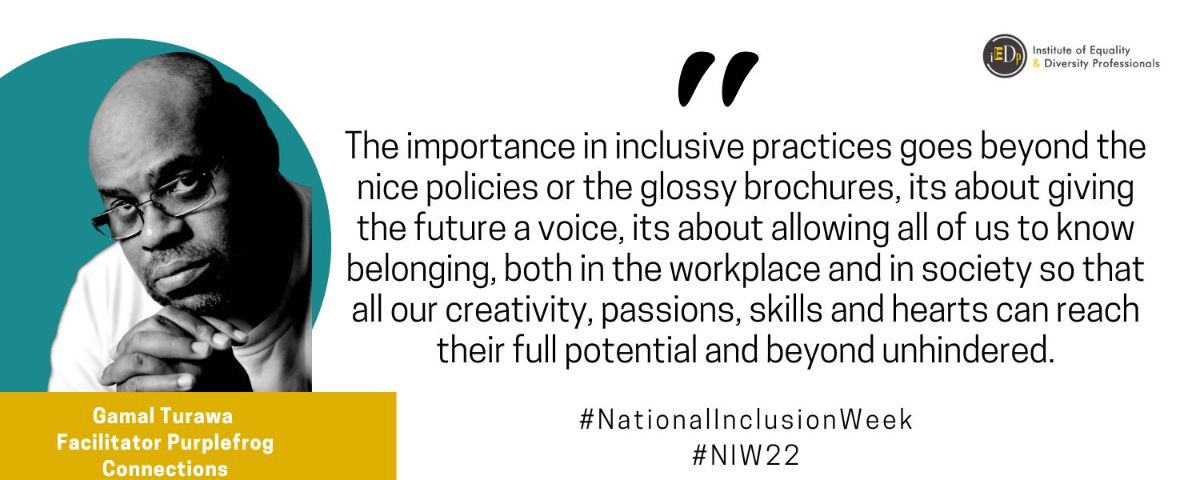
Growing up as a young Black Gay boy in both the UK and Nigeria in the 1970s and 80s I didn’t see any role models that I could relate to or mentors to guide or show me that I was included in society. I couldn’t hide my colour, however I did all I could to hide and suppress my sexual orientation because of the of the blatant and unrestrained homophobia that was around me and I was in that place until my late 30s and am even as I now approach my 60s I am still unravelling the legacy of that suppression. However now I am very visible and use my story to help others to find theirs. I want to be that person in the room whom I needed when I was that scared Black Gay boy.
National inclusion week for me is about celebrating ways in which those of us that are able to can be a beacon for those that need someone to give them confidence, something to aim for and above all give them hope in their own future.
The importance in inclusive practices goes beyond the nice policies or the glossy brochures, its about giving the future a voice, its about allowing all of us to know belonging, both in the workplace and in society so that all our creativity, passions, skills and hearts can reach their full potential and beyond unhindered. So don’t make National Inclusion week just a week, make it a way of being so that it becomes the fertiliser that grows a brighter world for us all.
Gamal Turawa
Facilitator Purplefrog Connections

The current landscape in the UK for Neurodiversity is in a period of flux and uncertainty. Organisations are reacting to unprecedented disclosure of unseen disabilities, attempting to understand their obligations and decide who should drive the portfolio. This uncertainty (and often confusion) provides opportunity for positive challenge and change but where do you start?.
5 years ago organisations were choosing not to engage in the Neurodiversity conversation, it wasn’t the right time or it wasn’t the right ‘focus’. Now, and for some time, it has been accepted as a ‘need to have’ but how do you start, how much does it cost and who should you go to for support?
Getting started is the hard part, doing something can often make for uncomfortable conversations and challenge. However we see everyday the impact that an organisation can have on neurodivergent individuals lifestyle, progression, well-being – the view of themselves. There is no ‘business case’ to prove anymore, just the answering of the question “Do you want to be relevant?”
Caroline Turner
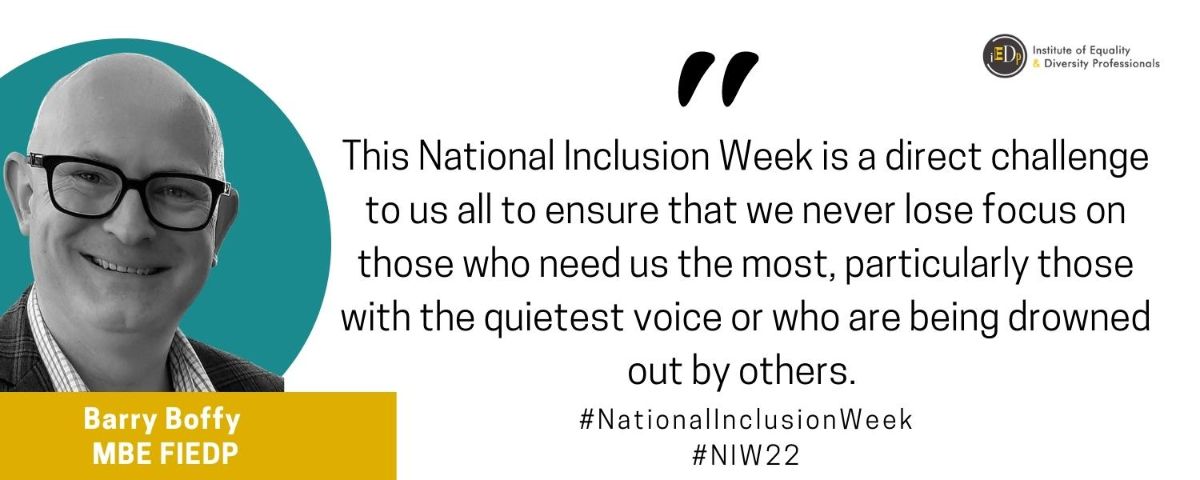
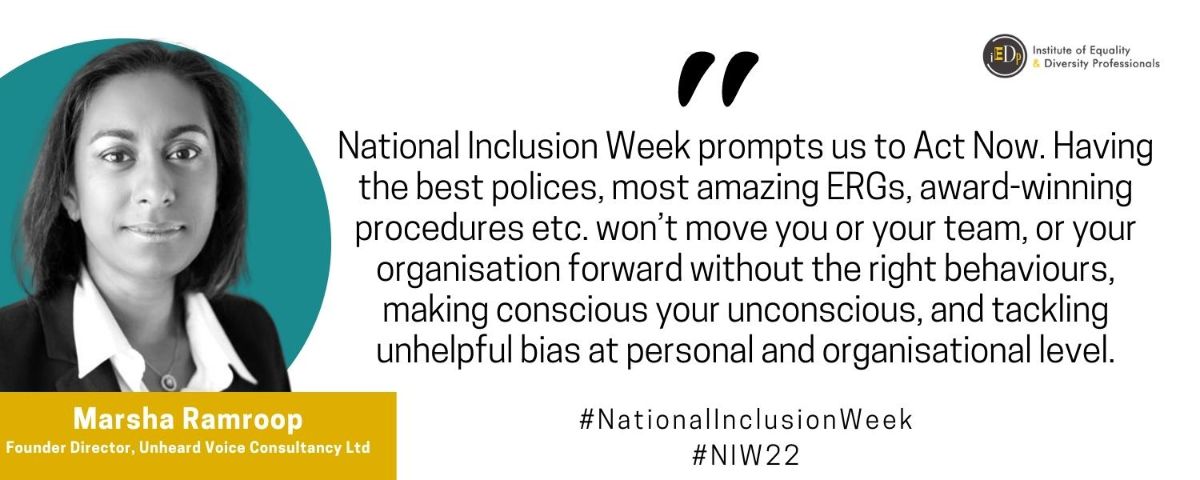
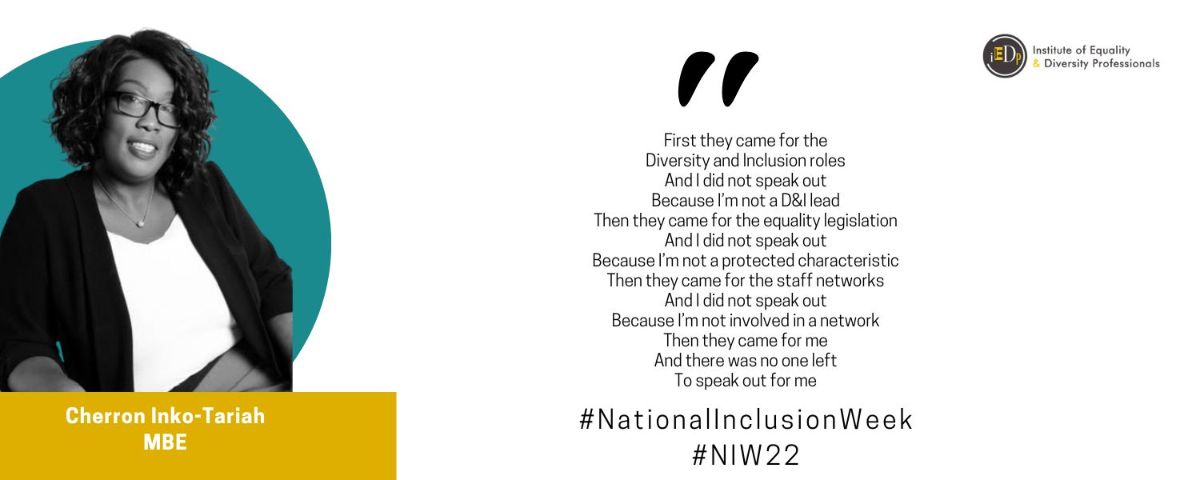
I tweaked the words of the poem ‘First they came’ by Martin Niemoller to reflect the impact.
The Rude Awakening
First they came for the
Diversity and Inclusion roles
And I did not speak out
Because I’m not a D&I lead
Then they came for the equality legislation
And I did not speak out
Because I’m not a protected characteristic
Then they came for the staff networks
And I did not speak out
Because I’m not involved in a network
Then they came for me
And there was no one left
To speak out for me
Cherron Inko-Tariah

It has been 78 years since the UK first legislated to close the Disability Employment Gap. Seventy-eight years! Yet, we still have employment rates for people with disabilities hovering just above 50% compared to just over 80% for non-Disabled people. The mid 1990s saw the introduction of the Disability Discrimination Act, which was then superseded by the Equality Act in 2010. Clearly, legislation isn’t having the desired affect. So in the spirit of the 2022 theme for National Inclusion Week, employers must recognise that “Time to Act: The Power of Now” isn’t just a clever slogan that that requires a week-long performative nod. Instead, it’s a rallying cry. With continued talent shortages affecting most sectors of the labour market, now is time to take action to leverage the enormous skills and value that an increase in employment for Disabled People will bring to businesses, the economy and society as a whole.
Tony McCaffrey
To mark NIW 2022, the Grey Area are excited to publish our third survey which is looking at the future of equity!
We have heard a worrying narrative from the government regarding its stance on the equity, diversity and inclusion agenda. For example:
· Promises to review the Equality Act 2010
· A push for “anti-wokism”
· Ministers now questioning the need for EDI practitioners;
· Efforts to suppress employee voice,
We at the Grey Area want to know how employees in the UK feel about the EDI agenda.
This should take about 5 minutes to complete and we welcome your thoughts because your voice matters!
https://www.smartsurvey.co.uk/s/BKAA02/
Hearing loss, deafness and/or tinnitus affect 12 million UK people so being fully aware and catering for the requirements of any staff members with additional needs is essential for inclusive employers.
For most employees with hearing loss, there should be no need to change jobs as extensive support is available. Hearing loss is an invisible disability so employers need to be aware of the challenges an employee may be facing.
Speaking openly about how hearing loss affects the ability to work may cause inhibition and embarrassment, even anxiety and pretending all is fine while straining to catch what people are saying, is common.
by Gamal ‘G’ Turawa
We are in unprecedented times and the challenges that has brought are pushing us to explore new options and ways of working and let's be honest for those that like to feel the energy of the room and use it to work their magic this is not ideal.
However if we look at the positives we have found ways to connect to the world through a tablet or computer screen. I recently found myself talking to delegates in 15 different countries from my sofa. There has been an explosion in how many ways we can now interact online all with various networking softwares with a myriad of conferencing features and facilities.
The pandemic, politics and injustices across the whole diversity spectrum have come to the fore in ways that have put our work front and centre and the market place is now becoming awash with ‘consultants and specialists.’ Buzzwords like unconscious bias, resilience, humanistic, allyship and inclusion are entering the vocabulary of our profession at a phenomenal rate. It seems that almost every conversation has to have them included if one wants to be taken seriously.
My childhood dream was to by a ballet dancer, Dame Margot Fontaine was my hero. Once I turned 16 I realised that dream would never come true. Musical Theatre replaced dancing – watching not performing!
ADHD month brings full circle my passions of ballet, musical theatre and neurodiversity in the of Gillian Lynne Choreographer.
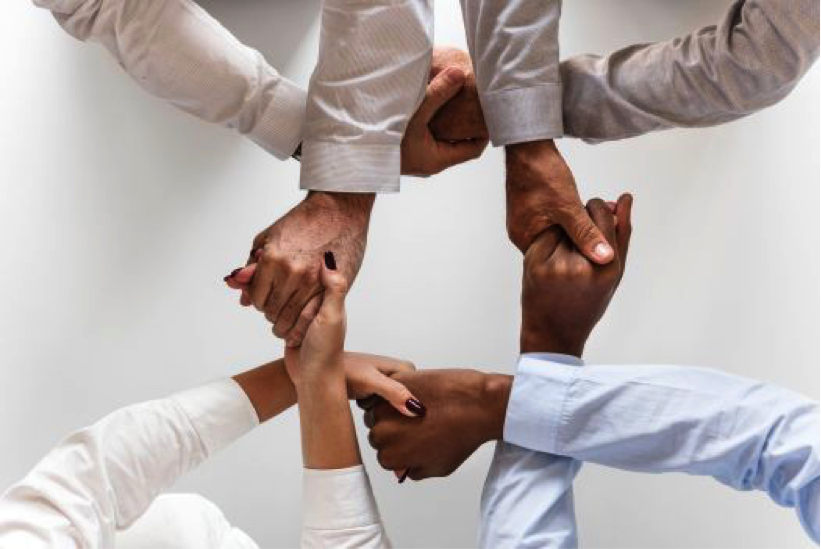
A short while ago, I posted on Twitter about privilege and the impact on me as racism, and I received a lot of challenge on that.
I – absolutely – understand the challenge, which is why the conversation is so important. What are our different perspectives? And how do we come together?
2020 is the year many would say that we witnessed two viruses killing black people: COVID19 and racism.
Many of our brothers and sisters were taken away from us this year – some before our very eyes. Breonna Taylor, Ahmaud Arbery, George Floyd to name a few. We saw hundreds of people from the Black community lose their lives to COVID 19 – many of whom were working on the frontline.
We also said goodbye to those precious souls, like Dame Jocelyn Barrow whose work has left an indelible mark on the Black community in the UK.
2020 has truly tested us. It nearly broke us.
In 1971 the then Commissioner for the Metropolitan Police in London, Sir Robert Mark was concerned about relationships between the Police and the then called 'coloured' communities of London and he launched an initiative that sought to recruit more 'coloured' people to become police officers.
The ‘Pause…’ programme for people who have been furloughed or who are working from home (and could use some support). 12 modules packed with useful and insightful content to help navigate discombobulating times.
Do you remember that programme called Monk? The former police detective who suffered a breakdown after the death of his wife Trudy. Monk had numerous compulsive habits and a number of phobias but had a sharp memory and could solve the most complex of cases.
But one nearly got the better of him.
There has been much discussion of late in the international HIV community of comparison between the current Covid 19 pandemic and the ongoing global HIV/AIDS pandemic. In terms of the statistics, as of today, 29 April there are 2.8M cases of Covid 19 worldwide, and more than 200K deaths worldwide. Since the start of the HIV/AIDS epidemic in 1981 an estimated 74.9 million people globally have become infected with HIV and 32 million people have died of AIDS-related illnesses.